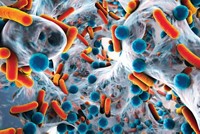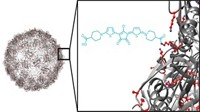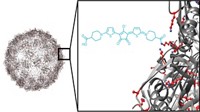Advertisement
Grab your lab coat. Let's get started
Welcome!
Welcome!
Create an account below to get 6 C&EN articles per month, receive newsletters and more - all free.
It seems this is your first time logging in online. Please enter the following information to continue.
As an ACS member you automatically get access to this site. All we need is few more details to create your reading experience.
Not you? Sign in with a different account.
Not you? Sign in with a different account.
ERROR 1
ERROR 1
ERROR 2
ERROR 2
ERROR 2
ERROR 2
ERROR 2
Password and Confirm password must match.
If you have an ACS member number, please enter it here so we can link this account to your membership. (optional)
ERROR 2
ACS values your privacy. By submitting your information, you are gaining access to C&EN and subscribing to our weekly newsletter. We use the information you provide to make your reading experience better, and we will never sell your data to third party members.
Nanomaterials
Living cells don nanoparticle armor
Tough coatings protect cells and augment them with magnetism and fluorescence for possible biotech applications
by Mark Peplow, special to C&EN
May 15, 2019
| A version of this story appeared in
Volume 97, Issue 20

Move over, Iron Man—now cells have got their own protective suit of armor. By encasing living cells in an exoskeleton of nanoparticles, researchers have imbued them with a range of superpowers, including magnetism, fluorescence, enhanced stiffness, and resistance to harsh chemical conditions (Adv. Mater. 2019, DOI: 10.1002/adma.201900545). These ‘SupraCells’ could eventually help study cell biochemistry or deliver medical therapies, says C. Jeffrey Brinker of the University of New Mexico, part of the team behind the work
To make their first SupraCell, the team mixed HeLa cancer cells with 50-nm-wide particles of a metal-organic framework (MOF) called ZIF-8. They then added tannic acid, which binds to zinc in the MOF, to form a tough network of nanoparticles around each cell in less than 1 min. Over 90% of the cells remained metabolically active, but they were unable to spread or reproduce.
More SupraCells soon followed, combining a variety of MOFs and other nanoparticles with different cell types. “It’s so easy, and so fast,” Brinker says. “We were somewhat surprised by how well it worked.”
Safe inside their exoskeletons, some SupraCells were protected from acids, bases, and hydrogen peroxide. They were also largely unaffected by 1 h of exposure to ultraviolet light, which killed 70% of unprotected cells. “You can put them in conditions that normal cells could never survive,” Brinker says.
The shields are not completely impenetrable, though. Tests on one SupraCell showed that a glucose-based fluorescent tracer, and the anticancer drug doxorubicin, could both pass through pores in the synthetic exoskeleton and into the cell. However, the armor blocked silver nanoparticles, roughly 5 nm across, and could fend off Salmonella bacteria. Based on those observations, the team concluded that the cells could take in nutrients to keep them alive, as well as small molecules that control their metabolism, without fearing attack from other cells in the body.
To free the cells from ZIF-8, the researchers simply add ethylenediaminetetraacetic acid, which bonds with zinc and breaks open the exoskeleton. “They behave identically to the native cells after we removed the nanoparticles,” Brinker says.
These SupraCells are not the first examples of encapsulated living cells. Other groups have previously covered cells with polymer coatings or silica nanoparticles, for example. But these processes have typically been slow, limiting the types of shell materials that can be used without killing the cells, and it has been difficult to control the permeability of the shells.
The SupraCells can also contain different nanoparticles within the same shell, potentially giving them multiple functions. “They can combine different types of materials to tune their function and porosity,” says Insung Choi at the Korea Advanced Institute of Science and Technology, who works on cell encapsulation but was not involved in this work. “That is the new thing, and it’s a really interesting strategy.”
Brinker’s team is still exploring potential applications. A SupraCell with a skeleton of magnetic iron oxide nanoparticles can be moved around by an external magnetic field, for example, potentially offering a way to remove it from an animal’s blood. Another SupraCell carries a fluorescent MOF coating that stops glowing in the presence of nitric oxide, a common signaling molecule that cells produce in times of stress. This could provide a way to monitor the well-being of the cell inside the shell, Brinker says.
Choi also suggests that the encapsulation method could protect cells used in cell therapy, which may be vulnerable to stressful processes like centrifugation or prone to attack by immune-system proteins called cytokines. “You could really increase cell viability this way,” he says.
The researchers have already started to study how SupraCells behave inside mice, and found they can circulate safely for days. “The next stage is going to be looking at their behavior in vivo more closely, and coming up with the killer app,” Brinker says.





Join the conversation
Contact the reporter
Submit a Letter to the Editor for publication
Engage with us on Twitter